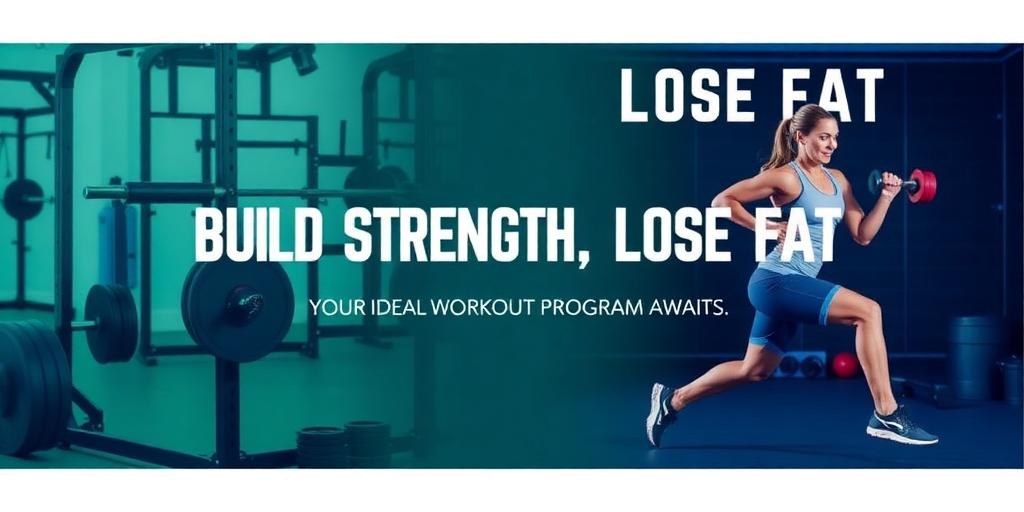Embarking on a fitness journey can be overwhelming, especially when trying to navigate the vast landscape of workout programs. The key to achieving your goals – whether it's building strength, losing fat, or both – lies in understanding the fundamental principles of exercise science and tailoring a program to your individual needs. This guide will provide you with the knowledge and tools to design an effective workout program that aligns with your objectives.
Understanding the Basics
Before diving into specific workout routines, let's establish a foundation of key concepts:
- Progressive Overload: This principle dictates that you must gradually increase the demands on your muscles over time to stimulate growth and strength gains. This can be achieved by increasing weight, reps, sets, or decreasing rest time.
- Specificity: Your training should be specific to your goals. If you want to build strength, focus on heavy weightlifting with lower reps. If your goal is fat loss, incorporate more cardio and higher rep ranges.
- Recovery: Adequate rest and recovery are crucial for muscle repair and growth. Aim for 7-9 hours of sleep per night and incorporate rest days into your workout schedule.
Designing Your Workout Program
Here's a step-by-step guide to creating your ideal workout program:
- Assess Your Fitness Level: Before starting any new program, evaluate your current fitness level. This will help you determine appropriate starting weights and exercise intensities. Consider consulting with a fitness professional for guidance.
- Define Your Goals: Clearly define your goals. Are you primarily focused on building strength, losing fat, or both? This will dictate the type of exercises and training volume you incorporate.
- Choose Your Exercises: Select exercises that target all major muscle groups. Compound exercises like squats, deadlifts, bench press, and overhead press are highly effective for building overall strength and muscle mass. Isolation exercises can be used to target specific muscles.
- Set Your Sets and Reps:
- Strength Training: 3-5 sets of 4-8 reps with heavy weight.
- Hypertrophy (Muscle Growth): 3-4 sets of 8-12 reps with moderate weight.
- Endurance: 2-3 sets of 12-15+ reps with lighter weight.
- Determine Your Workout Split: A workout split refers to how you divide your training across the week. Common splits include:
- Full Body: Train all major muscle groups in each workout (3 times per week).
- Upper/Lower: Divide your workouts into upper body and lower body days (4 times per week).
- Push/Pull/Legs: Group exercises based on movement patterns (6 times per week).
- Incorporate Cardio: Cardio is essential for fat loss and overall cardiovascular health. Aim for at least 150 minutes of moderate-intensity cardio or 75 minutes of vigorous-intensity cardio per week.
- Track Your Progress: Keep a record of your workouts, including the exercises you perform, the weight you lift, and the number of reps you complete. This will allow you to track your progress and make adjustments to your program as needed.
Sample Workout Programs
Here are a few sample workout programs to get you started:
Strength-Focused Program (3 days per week, Full Body)
- Day 1:
- Squats: 3 sets of 5 reps
- Bench Press: 3 sets of 5 reps
- Barbell Rows: 3 sets of 5 reps
- Day 2:
- Deadlifts: 1 set of 5 reps
- Overhead Press: 3 sets of 5 reps
- Pull-ups: 3 sets to failure
- Day 3:
- Front Squats: 3 sets of 8 reps
- Incline Dumbbell Press: 3 sets of 8 reps
- Dumbbell Rows: 3 sets of 8 reps
Fat Loss-Focused Program (5 days per week, Upper/Lower Split + Cardio)
- Monday: Upper Body
- Bench Press: 3 sets of 10-12 reps
- Dumbbell Rows: 3 sets of 10-12 reps
- Overhead Press: 3 sets of 10-12 reps
- Bicep Curls: 3 sets of 12-15 reps
- Triceps Extensions: 3 sets of 12-15 reps
- Tuesday: Lower Body + Cardio
- Squats: 3 sets of 10-12 reps
- Lunges: 3 sets of 10-12 reps per leg
- Hamstring Curls: 3 sets of 12-15 reps
- Calf Raises: 3 sets of 15-20 reps
- 30 minutes of moderate-intensity cardio (e.g., jogging, cycling)
- Wednesday: Rest
- Thursday: Upper Body (repeat Monday's workout)
- Friday: Lower Body + Cardio (repeat Tuesday's workout)
- Saturday: 45 minutes of moderate-intensity cardio (e.g., swimming, hiking)
- Sunday: Rest
Key Considerations
- Proper Form: Prioritize proper form over lifting heavy weight. This will help prevent injuries and ensure you're targeting the correct muscles.
- Listen to Your Body: Pay attention to your body's signals and don't push yourself too hard, especially when starting a new program. Rest when you need to, and don't be afraid to modify exercises if you're experiencing pain.
- Nutrition: Your diet plays a crucial role in achieving your fitness goals. Focus on eating a balanced diet with plenty of protein, healthy fats, and complex carbohydrates.
- Consistency: Consistency is key to seeing results. Stick to your workout program as consistently as possible, even when you don't feel like it.
Conclusion
Building strength and losing fat requires a well-designed workout program that aligns with your individual goals and fitness level. By understanding the fundamental principles of exercise science, choosing appropriate exercises, and incorporating progressive overload, you can create a program that helps you achieve your desired results. Remember to prioritize proper form, listen to your body, and stay consistent. With dedication and perseverance, you can transform your physique and achieve your fitness aspirations.









